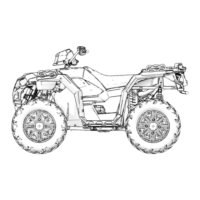4.8
2. Locate the fuel pressure valve
q
attached to the fuel
rail.
3. Remove the black cap and attach the fuel pressure
gauge kit and adaptor to the pressure valve. Route
the clear hose into a portable gasoline container or
the vehicle’s fuel tank.
4. Turn on the key switch to activate the pump and
check the system pressure on the gauge. If system
pressure of 58 psi (400 kPa) is observed, turn the
key switch “off” and depress the valve button on the
tester to relieve the system pressure.
Fuel Pump Pressure: 58 psi (400 kPa)
NOTE
If the fuel pressure is out of specification, replace the
fuel pump assembly.
5. If the pump did not activate (Step 4), disconnect the
plug from the fuel pump. Connect a DC voltmeter
across terminals “3” and “4” in the plug on the vehicle
harness side. Turn on the key switch and observe
voltage to ensure a minimum of 7 volts is present.
NOTE
If the voltage was below 7 VDC, test battery, ignition
switch, EFI relay and wiring harness.
6. If the reading is between 7 and 14 volts, turn key
switch off and connect an ohmmeter between the
terminals “3” and “4” in the plug on the pump to
check for continuity within the fuel pump.
NOTE
If there was no continuity between the pump terminals,
replace the fuel pump assembly.
7. If voltage at the plug was within the specified range,
and there was continuity across the pump terminals,
reconnect the plug to the pump, making sure you
have clean connections. Turn on the key switch and
listen for the pump to activate.
NOTE
If the pump starts, verify you have the correct amount of
fuel pressure.
8. If the pump still does not operate, check ECU
operation by plugging in a known-good ECU of the
same model.
NOTE
If the pump still does not operate, replace the fuel pump
assembly.
FUEL SYSTEM

